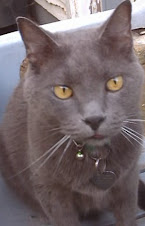 I recently hosted a Houses tip-in swap. There were 13 players, myself included. I made enough tip-ins for everyone and to compensate for being such a pig, I made two for each person. I had a total of 15 tip-ins (Judy sent me a different one for a hostess gift) and one lovely House shaped card sent me by Halle at Christmas. That made 16, for a total of 8 pages.
I recently hosted a Houses tip-in swap. There were 13 players, myself included. I made enough tip-ins for everyone and to compensate for being such a pig, I made two for each person. I had a total of 15 tip-ins (Judy sent me a different one for a hostess gift) and one lovely House shaped card sent me by Halle at Christmas. That made 16, for a total of 8 pages.This book, although not finished was inspired by a technique I found here: http://www.art_e_zine.co.uk/swhite.html
Please note that I have not shown any tip-ins other than my own, since I have not asked permission from the players to do so.
 I seldom take "before" photos, but this time I did. Here is the book I began with.
I seldom take "before" photos, but this time I did. Here is the book I began with. As you can see, it was an old discarded textbook
As you can see, it was an old discarded textbookTo begin, open the book. Note how the first page is attached to the front cover.
 The front side is now completely cut. I turned the book over and repeated for the back.
The front side is now completely cut. I turned the book over and repeated for the back. When finished, I had a book cover and the pages in the book, which I'll use in another project.
When finished, I had a book cover and the pages in the book, which I'll use in another project. Supplies for altering the cover: Gesso, foam brush, electric sander (alternative is a sanding block).
Supplies for altering the cover: Gesso, foam brush, electric sander (alternative is a sanding block). The sanded book will no longer have a shine or luster. Note how I used a sanding block directly under the "introductory readings." The mouse (electric sander) didn't remove the sticker, so I did, then hand sanded where it had been. The advantage to using an electric sander is that it gives a much smoother finish (and doesn't hurt your hands).
The sanded book will no longer have a shine or luster. Note how I used a sanding block directly under the "introductory readings." The mouse (electric sander) didn't remove the sticker, so I did, then hand sanded where it had been. The advantage to using an electric sander is that it gives a much smoother finish (and doesn't hurt your hands). When sanded, I wiped off the book with a lint free rag.
When sanded, I wiped off the book with a lint free rag. I then applied one coat of gesso to the outside of the book.
I then applied one coat of gesso to the outside of the book. While the book cover was drying, I used scraps of CS to make the connecting papers. These are the papers I attached the tip-ins to. You can see there are different sizes, both in width and length. I ended up cutting the length off some. Since many of the tip-ins were different heights, I tried to match up similar heights of pages. The front row started as white CS, to which I added silver and burnt umber glazes.
While the book cover was drying, I used scraps of CS to make the connecting papers. These are the papers I attached the tip-ins to. You can see there are different sizes, both in width and length. I ended up cutting the length off some. Since many of the tip-ins were different heights, I tried to match up similar heights of pages. The front row started as white CS, to which I added silver and burnt umber glazes. This page is ready to be assembled. I started by gluing 1/2" of tip-in to the CS that I cut to size. When dry, I used a Crop-a-dile (not pictured for some reason) to cut holes at the top and bottom of each page, then used it to add the eyelets. When necessary, I used my "anywhere" hole punch/eyelet setter for the holes and eyelets the Crop-a-dile wouldn't reach. I used only the Crop-a-dile on the right side (in the picture), but the two middle snap holes were made using the hole punch and a hammer.
This page is ready to be assembled. I started by gluing 1/2" of tip-in to the CS that I cut to size. When dry, I used a Crop-a-dile (not pictured for some reason) to cut holes at the top and bottom of each page, then used it to add the eyelets. When necessary, I used my "anywhere" hole punch/eyelet setter for the holes and eyelets the Crop-a-dile wouldn't reach. I used only the Crop-a-dile on the right side (in the picture), but the two middle snap holes were made using the hole punch and a hammer.I bent the CS so it will fit over the rest of the stack which you can see in the top of the photo. This is actually the back of page 1 (left) in the book and the front of the last page(right).
 I simply flipped the page over. Now the back is on the left and the front is on the right. As for which side I glued under the CS, it depended on the tip-in and which side had the least art to lose.
I simply flipped the page over. Now the back is on the left and the front is on the right. As for which side I glued under the CS, it depended on the tip-in and which side had the least art to lose.
 I simply flipped the page over. Now the back is on the left and the front is on the right. As for which side I glued under the CS, it depended on the tip-in and which side had the least art to lose.
I simply flipped the page over. Now the back is on the left and the front is on the right. As for which side I glued under the CS, it depended on the tip-in and which side had the least art to lose.  This is the last tip-in in the book (mine) after the stack (below) was assembled.
This is the last tip-in in the book (mine) after the stack (below) was assembled. This is what the tip-ins look like after they were mounted on connecting CS and placed in a stack based on their size. My tip-in is first.
This is what the tip-ins look like after they were mounted on connecting CS and placed in a stack based on their size. My tip-in is first. The inside middle showing the different sizes of the pages that make up the signatures. Although I don't have photos, I made three holes in the eight centers. I was going to make two signatures, but settled on one. I should have gone with my first impulse, because eight pieces of CS and the book spine were too thick for a single eyelet. I ended up adding extra eyelets to the first four pages, which were not attached to the spine. This turned into a nightmare when I tried to bind the book. Also, since I only used three holes, I ended up with one strand of the fiber on the inside rather than the outside, so I had to loop the fiber around itself and push it thru the center hole, which I started from.
The inside middle showing the different sizes of the pages that make up the signatures. Although I don't have photos, I made three holes in the eight centers. I was going to make two signatures, but settled on one. I should have gone with my first impulse, because eight pieces of CS and the book spine were too thick for a single eyelet. I ended up adding extra eyelets to the first four pages, which were not attached to the spine. This turned into a nightmare when I tried to bind the book. Also, since I only used three holes, I ended up with one strand of the fiber on the inside rather than the outside, so I had to loop the fiber around itself and push it thru the center hole, which I started from. Although the book isn't bound too well, it is holding up OK and seems relatively stable. I originally tried to use two fibers, but couldn't get them thru the middle hole a second time, much less a third time.
 A closeup of the inside middle.
A closeup of the inside middle.
 This is the inside back cover. I was gifted with a postcard and a house shaped tag from two of the players. I wanted something with the house theme to hold them, but couldn't think of a way to make a pocket from a house. Somehow it hit me about the little old lady who lived in a shoe. I went on the internet and found a shoe image. The shoe was primarily white, so I reversed the color in Photoshop, making it primarily black. Then I printed it on purple paper. The title reads "They lived in a shoe." It is all mounted on some yummy textured pink paper I've had for awhile.
This is the inside back cover. I was gifted with a postcard and a house shaped tag from two of the players. I wanted something with the house theme to hold them, but couldn't think of a way to make a pocket from a house. Somehow it hit me about the little old lady who lived in a shoe. I went on the internet and found a shoe image. The shoe was primarily white, so I reversed the color in Photoshop, making it primarily black. Then I printed it on purple paper. The title reads "They lived in a shoe." It is all mounted on some yummy textured pink paper I've had for awhile.
 This shows the back side of the last tip-in (which is mine) and the inside back cover. You can see how the back of the eyelet faces the back of the tip-in.
This shows the back side of the last tip-in (which is mine) and the inside back cover. You can see how the back of the eyelet faces the back of the tip-in.
 My friend Dana came over and inspected what I did. She was also in the swap and curious as to how I mounted my tip-ins.
My friend Dana came over and inspected what I did. She was also in the swap and curious as to how I mounted my tip-ins.
 A closeup of the inside middle.
A closeup of the inside middle. This is the inside back cover. I was gifted with a postcard and a house shaped tag from two of the players. I wanted something with the house theme to hold them, but couldn't think of a way to make a pocket from a house. Somehow it hit me about the little old lady who lived in a shoe. I went on the internet and found a shoe image. The shoe was primarily white, so I reversed the color in Photoshop, making it primarily black. Then I printed it on purple paper. The title reads "They lived in a shoe." It is all mounted on some yummy textured pink paper I've had for awhile.
This is the inside back cover. I was gifted with a postcard and a house shaped tag from two of the players. I wanted something with the house theme to hold them, but couldn't think of a way to make a pocket from a house. Somehow it hit me about the little old lady who lived in a shoe. I went on the internet and found a shoe image. The shoe was primarily white, so I reversed the color in Photoshop, making it primarily black. Then I printed it on purple paper. The title reads "They lived in a shoe." It is all mounted on some yummy textured pink paper I've had for awhile. This shows the back side of the last tip-in (which is mine) and the inside back cover. You can see how the back of the eyelet faces the back of the tip-in.
This shows the back side of the last tip-in (which is mine) and the inside back cover. You can see how the back of the eyelet faces the back of the tip-in. My friend Dana came over and inspected what I did. She was also in the swap and curious as to how I mounted my tip-ins.
My friend Dana came over and inspected what I did. She was also in the swap and curious as to how I mounted my tip-ins. Before I added the signature, I painted the outside of the book turquoise pearl, then drew a picture of a house on the outside front. I then used the peeling paint technique from Claudine Hellmuth's "Discovery Workshop." When the first coat was dry, I applied vaseline in certain areas of the house, then applied purple paint. When dry, I wiped off the excess top layer of paint and the vaseline using a baby wipe. I left the middle free of the second paint, because I want to find an old door handle plate, to which I plan to add an old door handle I have.
Before I added the signature, I painted the outside of the book turquoise pearl, then drew a picture of a house on the outside front. I then used the peeling paint technique from Claudine Hellmuth's "Discovery Workshop." When the first coat was dry, I applied vaseline in certain areas of the house, then applied purple paint. When dry, I wiped off the excess top layer of paint and the vaseline using a baby wipe. I left the middle free of the second paint, because I want to find an old door handle plate, to which I plan to add an old door handle I have. This photo, taken from the top of the book, shows all the tip-ins after they were assembled in the book.
This photo, taken from the top of the book, shows all the tip-ins after they were assembled in the book.The book was a nightmare to make, but it was only my first one. I think it's a very good idea for keeping a small swap together. The book is large enough for these pages, but not so large the few tip-ins would get lost in the fray of a large book. The next one I make will have more signatures and I'll use heavy waxed linen thread rather than the bulky fiber.





.jpg)










.jpg)


































































.JPG)






























2 thoughtful remarks:
Just LOVE this book! All the different size pages are wonderful. I really enjoyed how you documented the making of this book with all the steps and photos. Thanks for sharing!
Best-
Ingrid
Your book is brilliant~
Thank you so much for sharing.
I am new to making books and journals.
Forgive my stupidity but what is a "tip in"?
Post a Comment